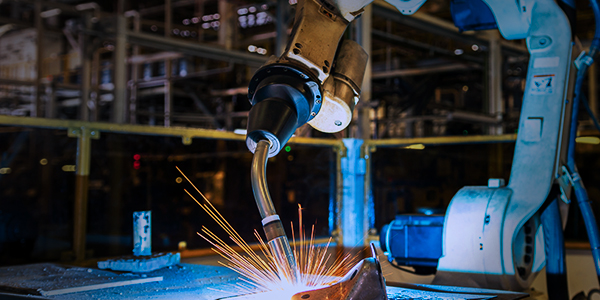INNOVATE
Robots walk among us
Singapore already has one of the highest numbers of industrial robots per employee in the world. The challenge now is mass deployment of these robots in a fragmented and complex market.
(This story is brought to you by A*STAR and ROS-Industrial Asia Pacific Consortium.)

At 398 robots for every 10-000 employees- Singapore has the second highest robot density in the world. This is nearly six times the world average of 69 robots per 10-000 employees- as reported in the 2016 International Federation of Robotics (IFR) annual report.
This high adoption rate- especially among Singapore-based manufacturers- is because robots offer an obvious solution for the industry's staff shortage. They also allow manufacturers to reduce energy consumption- factory floor space- and exposure to dangerous chemicals or processes.
According to the IFR report- Singapore's robot deployment rate grew 20 per cent each year between 2010 and 2015 - higher than the global robot growth rate of 16 per cent.
However- many companies have yet to fully maximise the use of robots in their operations. This is because many industrial robots are based on complex- customised software - making it extremely expensive to develop manufacturing solutions for each company. The high degree of specialization also means that it is contingent on the pool of robotic programmers available.
But what if there is a standard operating system that can make these robots easier to understand and use?
One ROS to rule them all
Enter the Robot Operating System (ROS)- a set of tools and libraries that can be used to power robots around the world.
Unlike specialized robot software- ROS libraries use various programming languages contributed by many users worldwide. This makes it accessible for the average programmer to use- create and contribute to the growth of ROS libraries.
This is similar to how web pages are created with a standard language called Hypertext Markup Language or HTML. Having a standard language allows different users to share information- play and socialise on the web.
"The best part is that the ROS source code is freely available on the Internet for anyone to access."
The best part is that the ROS source code is freely available on the Internet for anyone to access. While software code is usually kept under wraps as a trade secret- ROS is open-source- and the developer community is able to edit and improve the code that powers it. As a result- ROS has become very popular among researchers worldwide.
Being open-source also means that the ROS can be a game changer for small and medium enterprises (SMEs) that have found it too expensive to deploy robots on the factory floor.
"Being open-source also means that the ROS can be a game changer for small and medium enterprises (SMEs) that have found it too expensive to deploy robots on the factory floor."
ROS-Industrial (ROS-I) is the next step taken by the community- to extend capabilities of ROS to the manufacturing industry. ROS-I applications- such as advanced perception and path/grasp planning- can enable manufacturing robotic applications that were previously infeasible or cost-prohibitive.
Potential of ROS-I

In the West- ROS has been successfully implemented in advanced industrial robots. Sawyer is one of the more famous robots on the assembly line and is responsive to human touch. This enables factory workers to work alongside Sawyer without worrying that it will knock or injure them.
In Singapore- a local engineering SME Hope Technik has grand plans for its ROS-based invention- SESTO. The company has developed an exo-skeleton prototype for military- logistical and healthcare uses.
It is now setting its sights on exponential future growth with its SESTO Robotics line of automated guided vehicles (AGVs). These AGVs can carry heavy objects across narrow passages and among people without remote control. It is already employed in the semiconductor manufacturing and warehousing industries worldwide.
Consortium to raise awareness
However- ROS-I is considerably new to Singapore's shores and many local manufacturers are still unsure of its applications.
To encourage adoption of ROS-I- Advanced Remanufacturing & Technology Centre (ARTC)- in partnership with Nanyang Technological University (NTU) and Southwest Research Institute (SwRI) signed a MOU last year to set up the ROS-Industrial Asia Pacific Consortium. The Consortium was formally launched during the ROS-I Asia Pacific Workshop held at ARTC in May 2016.
The Consortium will act as a regional hub to close the gap between ROS research and application- by linking companies with technology providers and system integrators in the area. This allows participating companies - both large and small - to plan- create and collaborate on real-life manufacturing and industrial applications of ROS.
There are many potential use cases for ROS applications in Singapore- with two prominent examples being Scan-N-PlanTM technology and the PackML state machines.
The Scan-N-PlanTM technology enables robots to scan working surfaces of various sizes- and perform pre-programmed actions like welding- painting- and surface inspection. This technology automatically scans the sizes and shapes of the surfaces- and customises the actions accordingly. All this can be operated by the average employee- enabling manufacturers to respond quickly to changing conditions and reducing the need for programmers. The technology is currently at conceptual stage- and there is ongoing development to cater for edge surfaces and integration testing.
PackML (or Packaging Machine Language) states allow disparate packing machines previously working on different operating languages- to work together on a common platform with a consistent messaging protocol. This facilitates the integration of robots and programmable logic controller (PLC) from different vendors- which allows for improved control and monitoring capabilities.
By linking PackML with ROS-I- the integration of robots into complex manufacturing environments is now simpler.
Through the ROS-I initiative- we now have the expertise and infrastructure in place to industrialise the ROS platform- which will enable manufacturers to make use of and adapt robotic platforms with ease.
"Through the ROS-I initiative- we now have the expertise and infrastructure [to]...enable manufacturers to make use of and adapt robotic platforms with ease."
Although some applications still require further development- other ROS packages are ready for use (as a combination of system modules) to support production requirements. It would not be long before companies of all sizes are capable of deploying robots on their factory floors.
For more information about the ROS-Industrial Asia Pacific Consortium- please contact Consortium Manager Ms. Min Ling Chan at ros-i_asia@artc.a-star.edu.sg.
Was the article helpful?
A*STAR celebrates International Women's Day

From groundbreaking discoveries to cutting-edge research, our researchers are empowering the next generation of female science, technology, engineering and mathematics (STEM) leaders.
Get inspired by our #WomeninSTEM
